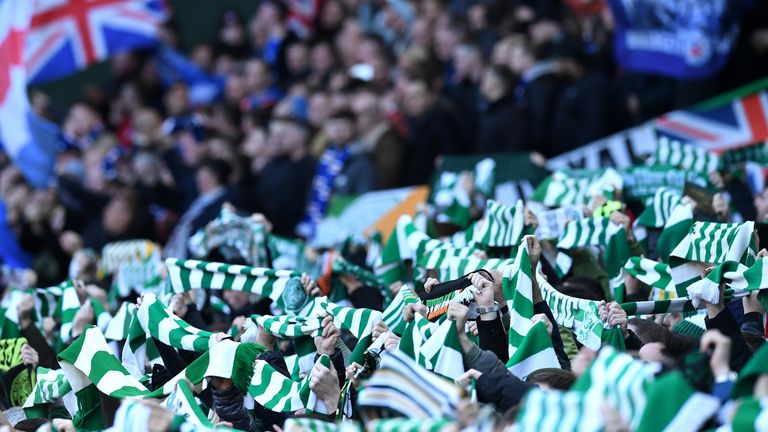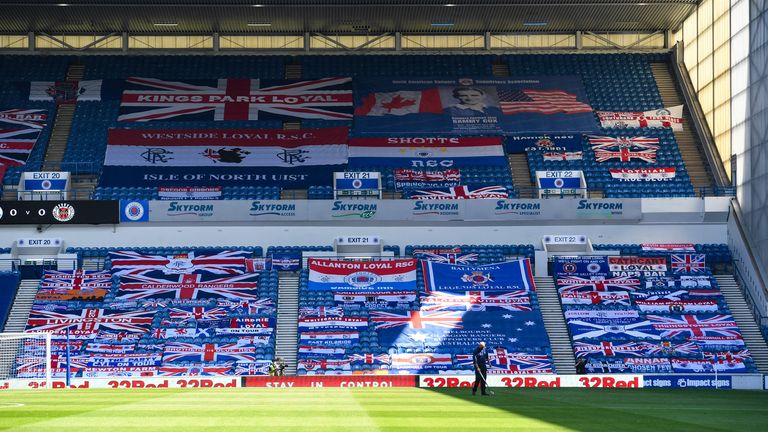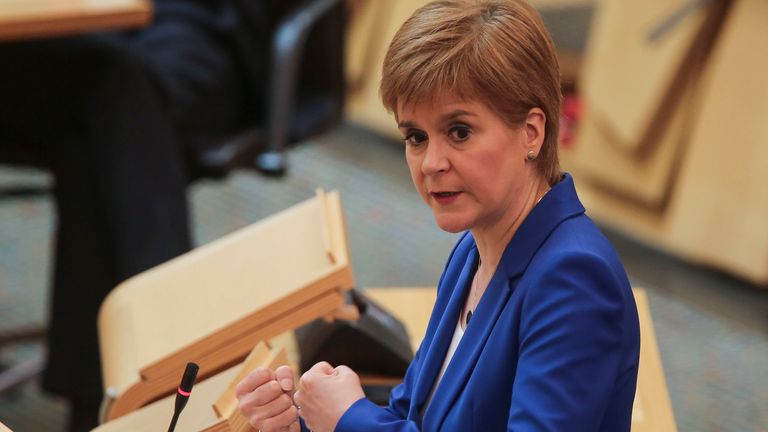Andy Walker: How and when fans could return to Scottish football
"I hope we'll never get used to our game being played behind closed doors"
Wednesday 26 August 2020 09:55, UK
In his latest column, Andy Walker gives his views on how and when fans could return to Scottish football.
I had to laugh at McDiarmid Park last Sunday as I made my way to the Sky commentary position for the St Johnstone vs Hibs game. A black curtain had been erected in front of my and Ian Crocker's monitors at the request of the St Johnstone board.
Apparently, they were unhappy at the volume of our commentary a few days earlier - maybe the content too especially when Aberdeen scored a late winner - and thought this curtain would enhance their viewing experience in yet another empty stadium.
Ian Crocker loves his Twitter and asked his army of followers what the best use of the curtain might be before we took it down. I think the best suggestion was to wrap his co-commentator in it and lock him in a room at the back of the stand for 90 minutes!
We laughed at Saints' request but it certainly highlighted how tough people are finding it watching top-level football in empty stadiums.
Trending
- World Darts Championship LIVE! Rock and Clayton headline afternoon session
- Saka out for 'many weeks' with hamstring injury
- Transfer Centre LIVE! Howe reluctant to sell Dubravka in January
- Usyk vs Fury 2: Fury 'robbed'? What do the stats reveal?
- Double blow! Sterling out 'for a while' - so will Arsenal sign a winger?
- Liverpool latest: Van Dijk plays down quadruple talk
- World Darts Championship schedule: Cross headlines Monday's action
- 'Cultural overhaul needed' | Neville slams 'mediocre' Man Utd
- Ref Watch: Pickford and Estupinan lucky to avoid unwanted Christmas cards?
- Man Utd latest: Neville says Rashford could go in January
- Watch the Old Firm derby live on Sky Sports
- Scottish Transfer Centre LIVE!
- Get Sky Sports - All channels £23 a month
I hope we will never get used to our game being played behind closed doors where as well as the dulcet tones of commentators, it is the echoes of players shouting or coaches and managers barking their instructions that fills the air.
We all miss fans not playing their part on matchday.
The coronavirus has sent shockwaves around the world and while efforts to suppress it and contain it remains at the top of the agenda, the public health risks are still too great for the mass gatherings of fans in stadiums.
That's why it is encouraging the Scottish government are beginning to think about test events for the safe return of fans at selected stadiums to see how the reality of getting a small number of supporters in attendance actually works.
How and when fans approach the ground? Do they need to queue to get in? How far apart do they sit once inside? How safe is it to use the toilet facilities? Will the food courts be open? What extra safety measures do the clubs have to provide? And of course, leaving the stadium to return home; all of these questions are under review.
Previously we have taken all these things for granted.
Celtic have been in talks with the Scottish government about allowing some supporters into Sunday's home clash with Motherwell, possibly around 700. It is a very small first step for so few people but it will be better than watching at home.
Clearly the hope is that the clubs and fans will learn a great deal about how we all need to adjust our behaviour to slowly get back to what we are used to.
In a stadium that holds 60,000, each lucky supporter will be lost in that enormous arena but it is a start.
I have noticed a few encouraging signs in Europe regarding football crowds in a post Covid-19 era. In Serbia, Partizan beat Red Star 1-0 in the Belgrade derby with 25,000 attending in June.
Celtic play Ferencvaros in a Champions League qualifier and the Hungarians also played in front of 16,000 last month.
Poland are seeing 9,000 at some of their games; Danish teams around 7,000.
First Minister Nicola Sturgeon has also hinted a small number of fans might be allowed to return to games in Scotland from September 14 providing we do not see a spike in the Covid-19 figures.
Hopefully, all Scottish clubs will get the chance to gradually ease back to some sort of normality but I fear it will be next season at the earliest before we see anything like regular full houses.
In order to see Celtic Park, Ibrox or Hampden with 50,000 or 60,000 in it again, it looks as though we will need to wait until a vaccine is found.
Testing the vaccine will clearly be time-consuming and even then I think everyone would accept that doctors, nurses and care workers would be first in line to receive the acquired immunity in order to carry out their life-saving duties.
The last step will be the general public having access to a vaccination that will be the new standard practice.
It is football but just not as we know it.








